Manual data entry is time-consuming, error-prone, and far from scalable in today’s data-driven world. That’s why businesses are turning to the best data capture software tools designed to automatically extract, process, and organize information from documents, forms, and images. The best solutions go beyond basic OCR, using AI and Intelligent Document Processing (IDP) to understand context, improve accuracy, and integrate seamlessly with your existing workflows. In this list, we’ll explore the 7 best data capture software solutions that help teams save time, cut costs, and make better data-driven decisions.
What is a data capture software solution?
Data capture software is designed to extract, process, and structure information from documents, forms, images, or digital files so that organizations can use it across their systems. Instead of manually entering information from invoices, contracts, or applications, data capture tools rely on advanced technologies like Optical Character Recognition (OCR), Machine Learning (ML), and Intelligent Document Processing (IDP) to turn unstructured or semi-structured content into clean, usable data.
In 2025, these solutions go beyond simple OCR. They now incorporate agentic AI, adaptive learning, and workflow automation to handle not just structured forms but also highly variable, complex documents. The result is faster processing, higher accuracy, and stronger compliance, giving organizations the freedom to scale without being held back by manual work.
Top industries that benefit from automated data capture software
While every industry that deals with documents can benefit, some sectors gain more immediate value due to high document volumes and compliance-heavy processes.
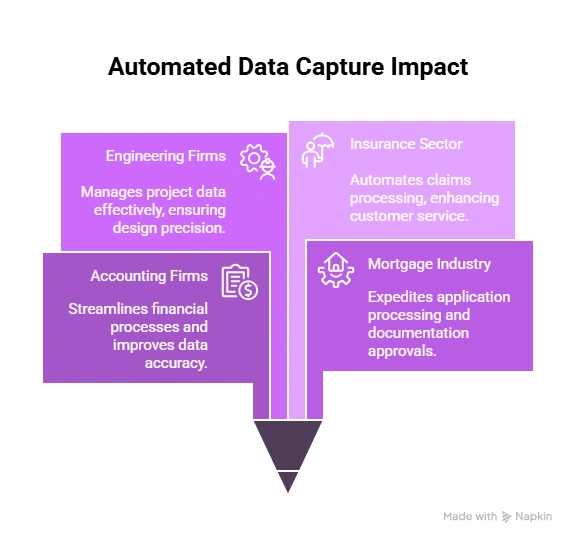
a. Accounting Firms
Accounting firms manage high volumes of invoices, receipts, tax forms, and payroll records every day. Manual entry slows down workflows and leaves room for reconciliation errors. Automated data capture streamlines this process by extracting and validating information in seconds, cutting processing times from hours to moments. This not only reduces errors but also frees staff to focus on higher-value services like client advisory and financial planning.
b. Mortgage
The mortgage industry is one of the most document-intensive areas in finance. Loan files often span hundreds of pages, including applications, pay stubs, tax returns, credit reports, and compliance disclosures. Manual reviews make the process slow and error-prone. Automated data capture in mortgage accelerates approvals by instantly extracting borrower details, validating income, checking disclosures, and flagging missing documents. For lenders, this leads to faster approvals, stronger compliance with CFPB and Fannie Mae guidelines, and fewer buyback risks. For borrowers, it means smoother experiences and quicker closings.
c. Engineering
Engineering teams deal with complex documents such as CAD drawings, blueprints, schematics, and P&IDs. These files contain precise measurements and component details that must be captured accurately to avoid costly errors. Manual reviews are time-consuming and prone to oversight. Automated data capture recognizes diagrams, extracts specifications, and organizes metadata instantly. This reduces rework, accelerates project timelines, and standardizes documentation across teams — enabling engineers to focus more on innovation and problem-solving rather than repetitive reviews.
d. Insurance
Insurance companies handle a constant flow of claims forms, policy documents, medical records, and regulatory paperwork. Manually processing this volume slows down claims handling and raises the risk of errors or fraud. Automated data capture software speeds up claims intake, verifies policyholder details, and flags missing or inconsistent information. The result is faster claims approval, improved accuracy in underwriting, and stronger fraud prevention — all of which translate into better customer service and operational efficiency.
Benefits of Using Data Capture Software Solutions
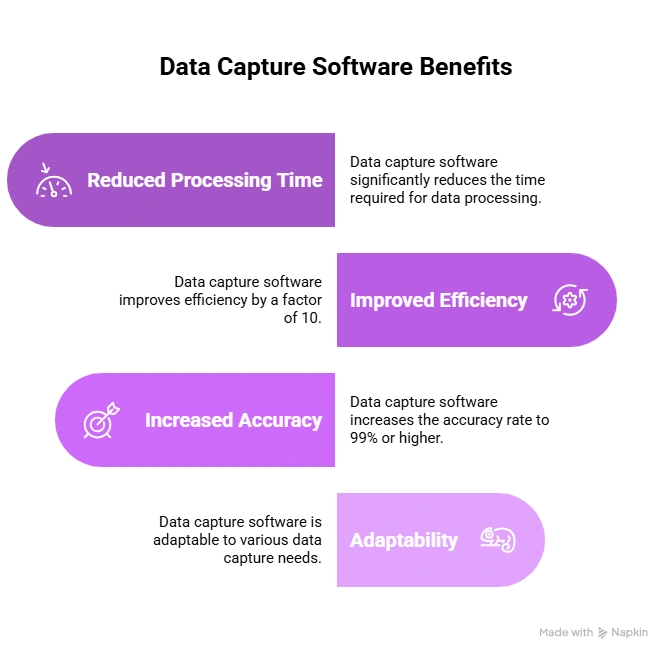
a. Reduce the processing time to 30–60 seconds
Modern systems can process documents almost instantly. What once took staff hours now takes under a minute, dramatically improving turnaround times.
b. Improve efficiency by 10x
Automation lets the same team handle significantly more work. A task that required 10 people can now be done by one or two with the help of AI-powered data capture.
c. Increase accuracy rate to 99%+
Advanced IDP platforms apply ML and AI to reduce human error. Even in complex layouts, accuracy rates exceed 99%, which improves data quality and trust in downstream systems.
d. Adaptability
Unlike traditional template-based OCR, modern data capture platforms adapt to new layouts, document types, or compliance rules automatically. This flexibility ensures long-term ROI.
Also read: Best Invoice scanning software in 2025
7 Best Data Capture Software Solutions
1. Infrrd – Built for Enterprise-Grade Document Intelligence
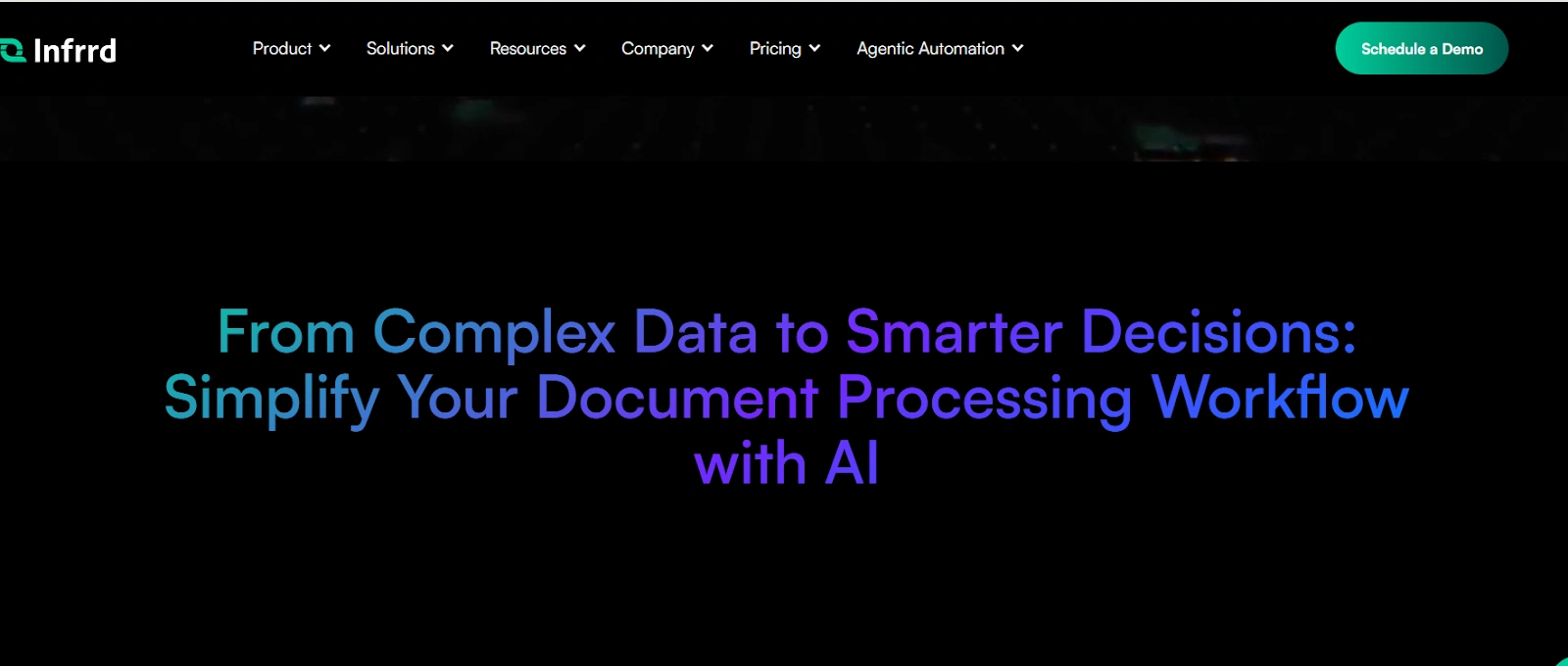
Infrrd is an enterprise-grade Intelligent Document Processing (IDP) platform built to handle complex, high-volume document workflows. Unlike template-based tools that struggle with variations, Infrrd uses machine learning models to extract data from structured, semi-structured, and unstructured documents with ease. It’s particularly strong in industries like mortgage, insurance, and manufacturing, where accuracy and compliance are critical.
Features
- Template-free, AI-driven extraction
- Handles structured, semi-structured, and unstructured documents
- Built-in SLA-based processing and exception handling
- Human-in-the-loop validation when required
- Seamless integrations with ERP and workflow systems like SAP, Oracle, and NetSuite
- Advanced agentic capabilities
Pros
- Flexibility without templates
- Strong support for complex layouts and tables
- Custom logic for industry-specific needs
- SLA awareness for priority routing
- Reliable performance at enterprise scale
Cons
- Best suited for mid-to-large enterprises
- It may be too advanced for very small businesses
Pricing
- Standard IDP for structured/semi-structured documents
- No-Touch Processing (NTP) for minimal human intervention
- AGP (Accuracy Guarantee Policy) for 100% accuracy via human+AI
- Custom enterprise solutions with Agentic AI for specialized, high-volume use cases
- Pricing is customized based on document volume, complexity, and AI requirements.
Reviews
Enterprises report faster implementations, higher ROI, and strong accuracy across diverse use cases, from mortgage audits to insurance claims and engineering drawings.
2. Grooper – For Technical Power Users

Grooper is a highly customizable platform built for organizations that want deep control over their document processing. It’s especially appealing to technical teams who need advanced rule-building, custom classifiers, and fine-tuned document logic. While it requires a steeper learning curve, Grooper shines in environments with complex or unusual data capture requirements.
Features
- Handles structured, semi-structured, and handwritten documents
- Advanced image preprocessing for noisy scans
- Deep customization with custom classifiers and business rules
Pros
- Highly adaptable with strong customization
- Supports cloud and on-prem deployments
- Integrates with CMS, databases, and business applications
Cons
- Steep learning curve
- Requires IT support for setup
- Less plug-and-play compared to SaaS competitors
Pricing
Pricing is not listed publicly. It typically depends on usage volume, features, and support packages.
Reviews
Users praise its depth and flexibility, but often note the complexity requires skilled technical resources.
3. Workato – Workflow Automation
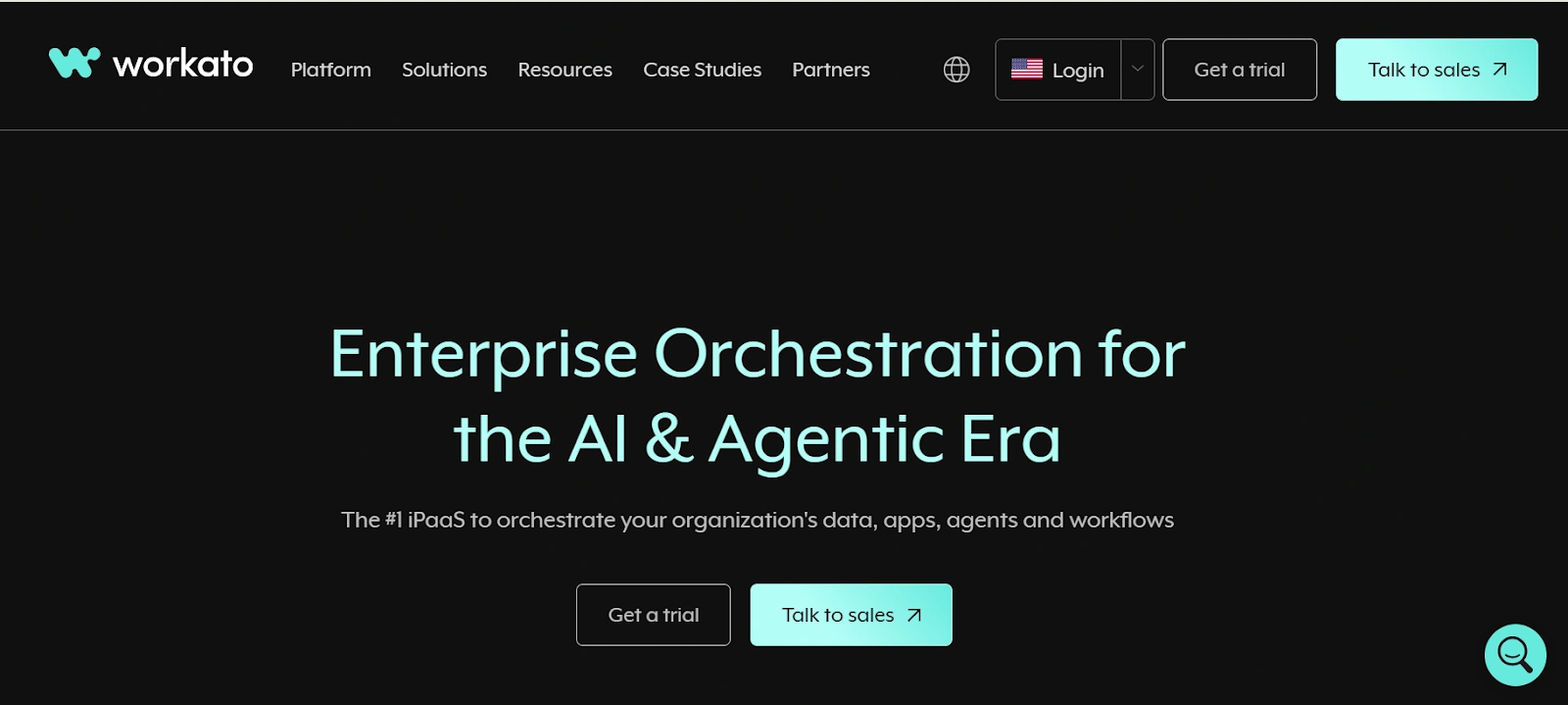
Workato is best known as an integration and automation platform, but it also provides document-trigger workflows. While it doesn’t natively extract data, it connects with OCR and IDP tools to create seamless end-to-end processes. For companies already invested in multiple SaaS platforms, Workato serves as the glue that makes document-based workflows flow effortlessly.
Features
- iPaaS platform with workflow automation
- Supports document-based triggers via connectors
- Strong SaaS integration ecosystem
Pros
- Excellent integration capabilities
- Flexible workflow automation across multiple apps
Cons
- No native document intelligence or OCR
- Requires external tools for full document automation
Pricing
- Pricing depends on connections, tasks, and user roles.
- High-volume recipes available for enterprises
Reviews
Best for organizations looking to tie document triggers into broader workflow automation, not for deep data capture.
4. Iron Mountain – InSight Intelligent Document Processing
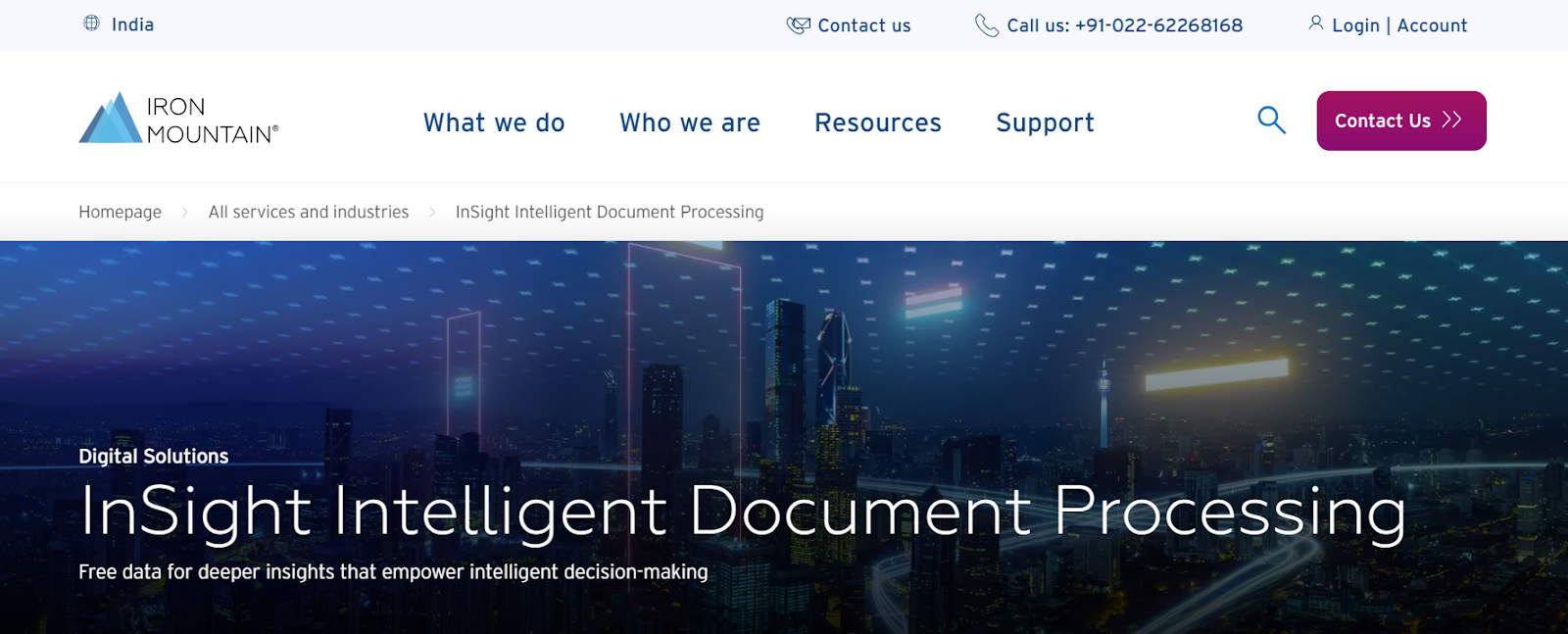
Iron Mountain, a long-established name in information management, recently expanded into Intelligent Document Processing with its InSight platform. Built for invoice and records automation, it combines AI-driven extraction with cloud scalability. While still relatively new in the IDP space, its brand credibility and focus on compliance-heavy industries make it a strong contender.
Features
- AI-powered invoice data extraction
- Cloud-based, scalable platform
- ERP integration and workflow automation
Pros
- Trusted brand in document management
- Strong invoice automation capabilities
Cons
- Newer to the IDP market (launched late 2024)
- May require IT support for integrations
- No on-premise deployment option
Pricing
Custom pricing by volume and features (document scanning, storage, shredding, cloud services).
Reviews
Still limited given its newness, but customers value the strong security and ERP integration.
5. AirSlate – Digital Forms Automation

AirSlate is tailored for organizations that rely heavily on digital forms and workflows. With built-in e-signatures and no-code setup, it’s especially popular with small to midsize businesses. While it may not handle highly complex unstructured documents, it’s a cost-effective way to digitize and automate paper-heavy processes.
Features
- Focused on digital forms and workflows
- E-signature support and automation templates
- Cloud-based with a drag-and-drop builder
Pros
- Simple setup for small-to-mid teams
- Good for forms-driven businesses
Cons
- Limited for complex, unstructured documents
- Best suited for SMBs
Pricing
Free Plan: $0 per month, includes 10 credits for basic usage, standard bots and integrations, and access to online support; unlimited users allowed.
Growth Plan: ~$399 /month (billed annually), includes 10,000 credits per year, email and chat support, plus one free Zoom session with a solutions consultant.
Automate 360 Plan: ~$799 /month (billed annually), includes 20,000 credits per year, API access, one premium integration, priority Zoom support, and a premium SLA.
Enterprise Plan: Custom quoted — includes all Automate 360 features plus custom integrations, deployment support, SSO, granular access control, enterprise reporting, and monitoring
Reviews
Praised for ease of use, but not ideal for enterprises with diverse document types.
6. Ephesoft (Now Part of Kofax)
Ephesoft, now under Kofax, has long been recognized for its intelligent capture and OCR solutions. Its focus lies in automating common back-office processes like accounts payable and receivable. While the acquisition has slowed some innovation, Ephesoft remains a reliable choice for businesses needing mature, proven invoice and receipt processing.
Features
- Cloud-based IDP with ML extraction
- Focus on invoices, receipts, and standard business docs
- Integrates with ERP and workflow tools
Pros
- Mature solution with proven OCR
- Good for AP/AR automation
Cons
- Now part of Kofax, limiting standalone roadmap
- May not match the innovation pace of newer players
Pricing
Custom quotes depending on features and volumes.
Reviews
Reliable for invoice and financial workflows, though some users note slower innovation post-acquisition.
7. Microsoft Power Automate (with AI Builder)

Microsoft Power Automate, paired with AI Builder, is a low-code automation solution designed for businesses already in the Microsoft ecosystem. While it’s not as powerful for complex or high-volume use cases, it’s affordable, integrates seamlessly with Microsoft apps, and works well for standard document types like invoices and IDs.
Features
- Low-code automation for the Microsoft ecosystem
- AI Builder for document recognition
- Works well with invoices, IDs, and receipts
Pros
- Deep integration with Microsoft apps
- Low-code interface
Cons
- Limited scope for complex/unstructured docs
- Basic exception handling
Pricing
- Premium Plan: ~$15 per user/month
- Per-Bot Plan: $150 per bot/month
- Hosted Process Plan: $215 per bot/month
Reviews
Great for Microsoft-centric organizations, but not ideal as a standalone data capture platform.
In a Nutshell
The right solution for your team depends on your document complexity, the systems you already use, and the resources your team can dedicate to managing it.
Every tool highlighted here brings unique strengths to the table. What works perfectly for one business may not fit another. That’s why it’s important to first evaluate your IT setup, the types of documents you process, and your long-term automation goals. The best data capture solution is the one that solves your needs today and scales with your business tomorrow.
Curious how the best data capture platform could boost your team’s productivity? Book a demo today.
Häufig gestellte Fragen
Software zur Überprüfung und Prüfung von Hypotheken ist ein Sammelbegriff für Tools zur Automatisierung und Rationalisierung des Prozesses der Kreditbewertung. Es hilft Finanzinstituten dabei, die Qualität, die Einhaltung der Vorschriften und das Risiko von Krediten zu beurteilen, indem sie Kreditdaten, Dokumente und Kreditnehmerinformationen analysiert. Diese Software stellt sicher, dass Kredite den regulatorischen Standards entsprechen, reduziert das Fehlerrisiko und beschleunigt den Überprüfungsprozess, wodurch er effizienter und genauer wird.
Eine QC-Checkliste vor der Finanzierung besteht aus einer Reihe von Richtlinien und Kriterien, anhand derer die Richtigkeit, Einhaltung und Vollständigkeit eines Hypothekendarlehens überprüft und verifiziert werden, bevor Mittel ausgezahlt werden. Sie stellt sicher, dass das Darlehen den regulatorischen Anforderungen und internen Standards entspricht, wodurch das Risiko von Fehlern und Betrug verringert wird.
IDP verarbeitet effizient sowohl strukturierte als auch unstrukturierte Daten, sodass Unternehmen relevante Informationen aus verschiedenen Dokumenttypen nahtlos extrahieren können.
KI verwendet Mustererkennung und Natural Language Processing (NLP), um Dokumente genauer zu klassifizieren, selbst bei unstrukturierten oder halbstrukturierten Daten.
Ja, IDP kann Dokumenten-Workflows vollständig automatisieren, vom Scannen über die Datenextraktion und Validierung bis hin zur Integration mit anderen Geschäftssystemen.
IDP nutzt KI-gestützte Validierungstechniken, um sicherzustellen, dass die extrahierten Daten korrekt sind, wodurch menschliche Fehler reduziert und die allgemeine Datenqualität verbessert wird.







